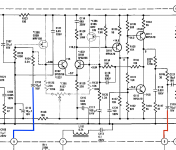Last year I restored a vintage Marantz 33 preamp. Unit sounds nothing short of amazing, but it has a small problem… 20db of gain. Sources these days usually have a 2V output (mine anyway), so I usually need unity gain.
My last work on the unit was replacing the volume slider (old one was shot and injected a lot of noise, plus a huge channel imbalance due to mechanical failings), and slow trying to reduce gain, by increasing R134 from 1k3 to 2k7 (see attached schematic - blue is input, red is output). This halved gain (measured on my scope), but didn’t help me get a better range on using the volume slider at all (I suspect the old one was attenuating more than it should so it inadvertently helped).
I’m thinking about lowering the gain even further. I should reach 2x if I increase R134 to 15k, if I understand the schematic correctly (1+R135/R134), but I’m not sure that’s the way to go. Should I also decrease R135? (maybe go with 7k5 for both). I have to admit I don’t fully understand how current affects this and if changing the “feedback” also impacts its frequency response/linearity.
Any advice is much appreciated.
My last work on the unit was replacing the volume slider (old one was shot and injected a lot of noise, plus a huge channel imbalance due to mechanical failings), and slow trying to reduce gain, by increasing R134 from 1k3 to 2k7 (see attached schematic - blue is input, red is output). This halved gain (measured on my scope), but didn’t help me get a better range on using the volume slider at all (I suspect the old one was attenuating more than it should so it inadvertently helped).
I’m thinking about lowering the gain even further. I should reach 2x if I increase R134 to 15k, if I understand the schematic correctly (1+R135/R134), but I’m not sure that’s the way to go. Should I also decrease R135? (maybe go with 7k5 for both). I have to admit I don’t fully understand how current affects this and if changing the “feedback” also impacts its frequency response/linearity.
Any advice is much appreciated.
Attachments
The natural way is to increase R134 or decrease R135 as you say. At least use a preset in place of R134 and find the gain you want.
20dB is ten times. I wonder why not to bypass it directly.
20dB is ten times. I wonder why not to bypass it directly.
The gain is 1+R134/R135, so adjust them both to give the desired ratio, preserving their sum so as not to upset loading. For A=1 use R134=0, R135=15k.
Last edited:
A sensible question and the answer is I’d like to preserve the unit as close as possible to the original. You could argue that changing the gain is the same, which is true, so I can just quote personal madness then 😅I wonder why not to bypass it directly.
I got an email notification of the original post where the values you mentioned were different (R134=4k7 and R135=10k). I do understand why you changed the values, as that would give an approx 3x gain instead of 1x, though I believe your formula has the resistors reversed (should be R134=10k and R135=4k7).The gain is 1+R134/R135, so adjust them both to give the desired ratio, preserving their sum so as not to upset loading. For A=1 use R134=0, R135=15k.
What I’m really keen on understanding: is how the total loading given by the feedback network affects the end result? How did they figure they need the original 16k3 (which is just summing up R134 and R135, though I guess we should take into account C116 and Q108 Rb, right?)
No mistake. 4k7 and 10k the way you have it gives A=1+10/4.7~=3. You said you wanted 2 or 1 and my first version gave 1.5.
The loading probably isn't critical here, but preserving the sum is the usual technique.
The loading probably isn't critical here, but preserving the sum is the usual technique.
Yes, you’re right, I had them mixed up in my head for some reason (I was doing the same calculations, but I had R134 grounded in my head)No mistake. 4k7 and 10k the way you have it gives A=1+10/4.7~=3. You said you wanted 2 or 1 and my first version gave 1.5.
